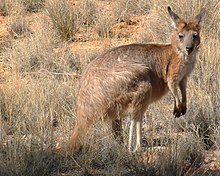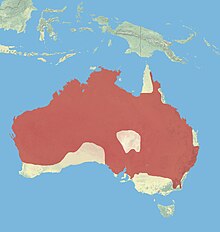Common wallaroo
| Wallaroo[1] | |
|---|---|

| |
| Euro (Macropus robustus erubescens) | |
| Scientific classification | |
| Kingdom: | |
| Phylum: | |
| Class: | |
| Infraclass: | |
| Order: | |
| Family: | |
| Genus: | |
| Species: | M. robustus
|
| Binomial name | |
| Macropus robustus Gould, 1841
| |
| Subspecies | |

| |
| Common wallaroo range | |
The common wallaroo (Macropus robustus) or wallaroo, also known as euro or hill wallaroo[2] is a species of macropod. The word euro is particularly applied to one subspecies (M. r. erubescens).[3]
The eastern wallaroo is mostly nocturnal and solitary, and is one of the more common macropods. It makes a loud hissing noise and some subspecies are sexually dimorphic, like most wallaroos.[4]
Subspecies
There are four subspecies of the wallaroo:[1]
- Eastern wallaroo (M. r. robustus)[3] – Found in eastern Australia, males of this subspecies have dark fur, almost resembling the black wallaroo (Macropus bernardus). Females are lighter, being almost sandy in colour.[4]
- Euro (M. r. erubescens) – [5] Found on covering most of its remaining range, this subspecies is variable, but mostly brownish in colour.[4]
- M. r. isabellinus – This subspecies is restricted to Barrow Island in Western Australia, and is comparatively small. It is uniformly reddish brown.[4]
- M. r. woodwardi – This subspecies is found in the Kimberley region of Western Australia and in a band running through Northern Territory. It is the palest subspecies and is a dull brown-grey colour.[4]
The eastern wallaroo (Macropus robustus robustus)—which is grey in colour—occupies the eastern slopes of the Great Dividing Range and the euro (Macropus robustus erubescens)—rufous in colour—occupies land westward.
Status
The eastern wallaroo as a species is not considered to be threatened, but the Barrow Island subspecies (M. r. isabellinus) is classified as vulnerable.[2]
References
- ^ a b Groves, C. P. (2005). Wilson, D. E.; Reeder, D. M. (eds.). Mammal Species of the World: A Taxonomic and Geographic Reference (3rd ed.). Baltimore: Johns Hopkins University Press. p. 65. ISBN 0-801-88221-4. OCLC 62265494.
- ^ a b c Template:IUCN2008
- ^ a b WE Poole and JC Merchant (1987): Reproduction in Captive Wallaroos - the Eastern Wallaroo, Macropus-Robustus-Robustus, the Euro, Macropus-Robustus-Erubescens and the Antilopine Wallaroo, Macropus-Antilopinus. Australian Wildlife Research 14(3) 225 - 242. online link
- ^ a b c d e Menkhorst, Peter (2001). A Field Guide to the Mammals of Australia. Oxford University Press. p. 118.
- ^ TF Clancy and DB Croft (1992): Population dynamics of the common wallaroo (Macropus robustus erubescens) in arid New South Wales. Wildlife Research 19(1) 1 - 15. online link
External links
- Animal Diversity Web
- Sedgwick County Zoo on Wallaroos
- Photos at ARKive.
- Fourth Crossing Wildlife - The Wallaroo and the Euro

